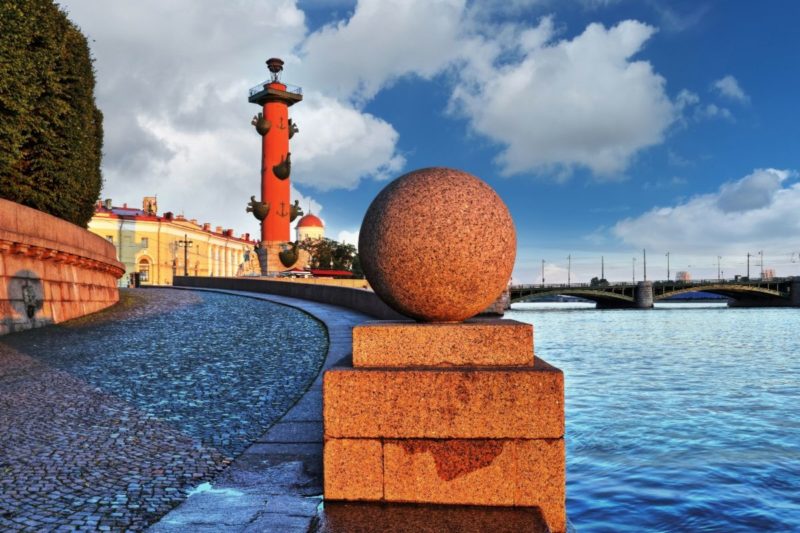Rostral Columns in St Peersburg

Rostral Columns are a famous landmark of St. Petersburg and an integral part of the ensemble of the Strelki of Vasilyevsky Island. They were installed on both sides of the Exchange by the architect Tom de Thomon in 1810 with an eye on the ancient Roman tradition of constructing columns-monuments with rosters (noses) captured in battle by the Carthaginian galleys. Initially, the St. Petersburg columns served as navigational beacons and symbolized the power of the Russian navy. Created from the Pudost stone, the 32-meter giants at the base have two sculptures each, symbolizing the great Russian rivers: the Volga and the Dnieper (the column nearest to the Palace Bridge/Dvortsovy Most) and the Volhov and Neva (the column closest to the Exchange Bridge/Birzhevoy Most).
Inside the column there are spiral staircases leading to the upper platforms, where metal tripods are placed with braziers designed for signal lights that lit in the fog at night. Initially, hemp oil was poured into the inside of the roaster, but its hot splashes often fell down onto the heads of passersby. Then the oil was replaced with tar, and in 1896 electric lamps were brought to the lamps. But due to the high cost of electricity, this method of lighting was rejected and the columns for some time ceased to be lit.
By the 250th anniversary of Leningrad (it so happened that it had to be celebrated four years later), gas workers were instructed to revive the long and very beautiful tradition to light the lights of Rostral columns. On June 6, 1957, at one of the columns, a trial launch of gas equipment was made, and already on June 23, Leningraders and guests of the city, who had come to the evening party on the Strelka of Vasilyevsky Island and the Neva Embankment, could admire the beauty of seven-meter bright lights. They are lit to this day on special occasions and holidays: on the Day of the City, on the Day of Victory, on the celebration of the graduates of the "Scarlet Sails" or the Day of the Navy.

Some facts about the columns:
- Rostrum is translated from Latin as “beak”. Enemy ships once rammed each other with such steel "beaks". In ancient Rome, sailors used iron on their ships' noses and used them as an additional advantage in battle.
- The first Rostral Column was erected in Rome during the Latin War (340 BC). It was built as a symbol of the naval victory of the Romans over the inhabitants of Carthage.
- In Russia, there are several such triumphal monuments, in addition to St. Petersburg, rostral columns are installed at the entrance to another sea port city - Vladivostok.
- Historians are still arguing whether the columns really were lighthouses. After all, high lamps were usually placed on the banks of a large reservoir, for example, the sea. They rarely appeared by the river, moreover in the center of a large city. According to one of the versions, the buildings from the very beginning served only as a symbol of victories and were lit on holidays, and did not work as lighthouses.
- Facing and sculptures of columns significantly suffered during the Great Patriotic War. In many places, the structure was damaged by fragments from shells and bombs. After the war, the worn parts were replaced with duplicates of polished copper sheets. Among them were platforms on which bowls-lamps are installed.
- In addition to Tom de Thomon, other masters of the 19th century worked on the large-scale project of columns. Among them are a native of a poor peasant family, the famous stonecutter S.K. Sukhanov, and foreign sculptors J. Camberlin and J. Thibault.
- It is worth noting that the design and construction of the facility was constantly monitored by the Council at the Academy of Arts. All details, from artistic appearance to practical importance, were discussed under the supervision of the great architect of the Academy A.D. Zakharov.
- At the end of the 20th century (in 1999) the last restoration work on the object was completed.
- Rostral columns more than once decorated money with their images. They were adorned on the bills of 50 rubles of 1997 and 50 thousand rubles of the 1995 sample.
- St. Petersburg Triumphal Columns are included in the Unified State Register of Cultural Heritage Objects (Historical and Cultural Monuments) of Russia.

